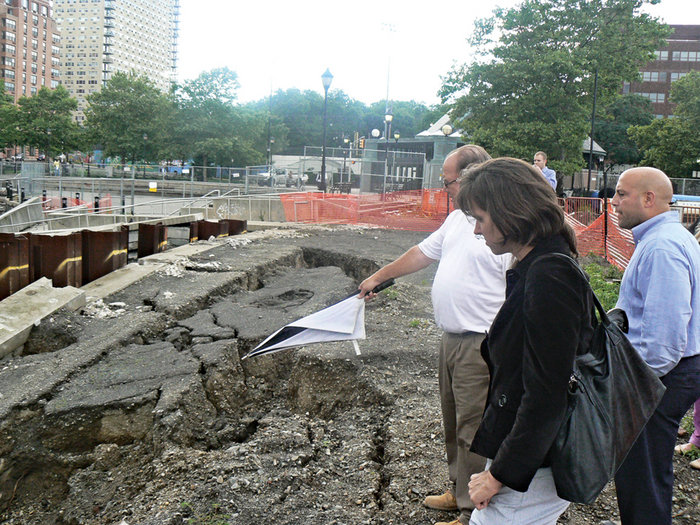Repairs to a pier at Sinatra Park have stalled while city officials seek an option that will ultimately prove costlier and could postpone the area’s reopening until August 2013.
Divers descended into the Hudson River last month as part of ongoing construction to restore the pier supporting the park at Fifth Street and Sinatra Drive. Shortly after construction began, however, divers noticed a dramatic increase in the deterioration of the supporting pilings, making continued work unsafe.
Mayor Dawn Zimmer sent a memo to the council saying that as of two years ago, the pilings had deteriorated 30 to 50 percent. Since that time, however, deterioration of the pilings has doubled to as much as 50 to 100 percent.
In fact, early last month, a section of the pier collapsed into a corrugated steel seawall that the city had installed. Engineers said that the seawall prevented the pier from further collapsing into the river.
“If you demolish the seawall, what keeps the river out? That’s the problem.” – Michael Nannini
____________
Now, the city has devised a new plan to install temporary sheeting all around the pier, removing 12,000 tons of soil, and to replace the wooden pilings with steel.
Boswell Engineering, the firm contracted to aid with the design of the pier’s construction, said that the project will once again need approval from the DEP and the U.S. Army Corps of Engineers.
$3 to $4M to remove seawall
Engineers Michael Nannini and Joseph Pomante of Boswell Engineering said that they expect to send their final project plans to both agencies this week. Nannini said that costs associated with the plan have not yet been estimated, but he predicts the project will cost “a lot” more than previous incarnations.
“It’s a total change of scope,” said Nannini, adding that in order for the pilings to be restored, the seawall has to be taken down, which can cost $3 to $4 million.
“If you demolish the seawall, what keeps the river out?” asked Nannini. “That’s the problem.”
Temporary sheets will be installed to separate the river from the pier until steel pilings can be installed. At that point, the city can reconstruct the seawall around the pier.
“You’re talking about a pier that has been here for 100 years,” said Pomante. “[The steel] will carry the weight better. That’s modern technology that you’re talking about.”
Nannini estimated that the new completion time for the project will be August 2013.
Weighing options
Zimmer said in her memo that a more cost-effective plan would have been to turn all of the area under the soccer field into solid land (currently the river flows underneath portions of the field). But the DEP indicated that they would not permit this plan because it would involve the loss of habitat under roughly one-third of the field, Zimmer said.
Zimmer also said in her memo that some City Council members suggested moving the entire soccer field onto land to avoid some of the costs. This approach, however, would take away 40 to 45 parking spaces on Sinatra Drive.
Zimmer also said that the facility for the planned Sinatra Café would have to be demolished and then rebuilt, which would have to be approved by the state’s Green Acres program.
Zimmer responded to suggestions by members of the council that the firms that designed and built the park be held accountable and pay the cost of repairs.
“The park was built in the late 1990s under Mayor Russo’s Administration,” said Zimmer in the memo. “If the council [chooses] to go in this direction, it would require a very challenging costly investigation and legal battle.”
“I believe this would be a fruitless effort that would only waste taxpayer money,” Zimmer later added.
Background
A portion of the pier initially collapsed into the river in September 2009. After an approximately two-year approval process, construction began last March, starting a long-term $7.7 million effort to restore the park. The plan had called for encasing the wooden piles in reinforced concrete, which would not have required the removal of 12,000 tons of soil.
Nannini said that although the approval process for the previous design was lengthy, he said he has received positive word from both agencies, and is hopeful the new plan will be approved in a timelier manner.
“They’ve been very gracious to talk to us unofficially,” said Nannini, adding that the new plans are more environmentally conscious. “We made a lot of progress with them.”
Nannini said they have sent preliminary plans to both regulatory agencies and will send a final plan at the end of this week.
Stephen LaMarca may be reached at slamarca@hudsonreporter.com.
